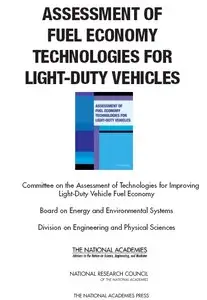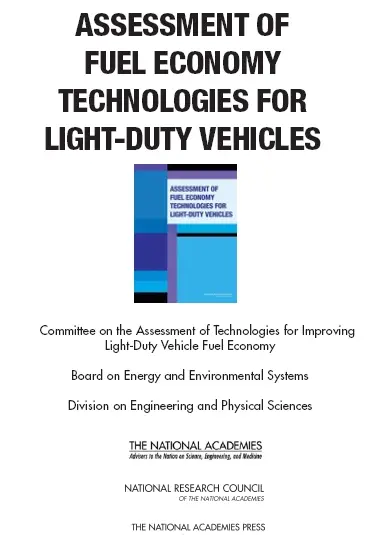Assessment of Fuel Economy Technologies for Light-Duty Vehicles
Committee on the Assessment of Technologies for Improving Light-Duty Vehicle Fuel Economy; National Research Council
NA Press | 2011 | ISBN: 0309156076 9780309156073 | 231 pages | PDF | 5 MB
Committee on the Assessment of Technologies for Improving Light-Duty Vehicle Fuel Economy; National Research Council
NA Press | 2011 | ISBN: 0309156076 9780309156073 | 231 pages | PDF | 5 MB
The book focuses on fuel consumption because energy savings are directly related to the amount of fuel used. In contrast, fuel economy measures how far a vehicle will travel with a gallon of fuel. Because fuel consumption data indicate money saved on fuel purchases and reductions in carbon dioxide emissions, the book finds that vehicle stickers should provide consumers with fuel consumption data in addition to fuel economy information.
Various combinations of commercially available technologies could greatly reduce fuel consumption in passenger cars, sport-utility vehicles, minivans, and other light-duty vehicles without compromising vehicle performance or safety.
Assessment of Technologies for Improving Light Duty Vehicle Fuel Economy estimates the potential fuel savings and costs to consumers of available technology combinations for three types of engines: spark-ignition gasoline, compression-ignition diesel, and hybrid.
According to its estimates, adopting the full combination of improved technologies in medium and large cars and pickup trucks with spark-ignition engines could reduce fuel consumption by 29 percent at an additional cost of $2,200 to the consumer. Replacing spark-ignition engines with diesel engines and components would yield fuel savings of about 37 percent at an added cost of approximately $5,900 per vehicle, and replacing spark-ignition engines with hybrid engines and components would reduce fuel consumption by 43 percent at an increase of $6,000 per vehicle.
Contents
SUMMARY
1 INTRODUCTION
Current Policy Context and Motivation
Statement of Task
Contents of This Report
References
2 FUNDAMENTALS OF FUEL CONSUMPTION
Introduction
Fuel Consumption and Fuel Economy
Engines
Fuels
Fuel Economy Testing and Regulations
Customer Expectations
Tractive Force and Tractive Energy
Detailed Vehicle Simulation
Findings and Recommendations
References
3 COST ESTIMATION
Introduction
Premises
Components of Cost
Factors Affecting Costs over Time and Across Manufacturers
Methods of Estimating Costs
Retail Price Equivalent Markup Factors
Findings
References
4 SPARK-IGNITION GASOLINE ENGINES
Introduction
SI Engine Efficiency Fundamentals
Thermodynamic Factors
Valve-Event Modulation of Gas-Exchange Processes
Gasoline Direct Injection
Downsized Engines with Turbocharging
Engine Friction Reduction Efforts
Engine Heat Management
Homogeneous-Charge Compression Ignition
Combustion Restart
Ethanol Direct Injection
Findings
Bibliography
Annex
5 COMPRESSION-IGNITION DIESEL ENGINES
Introduction
Technologies Affecting Fuel Consumption
Fuel Consumption Reduction Potential
Technology Readiness/Sequencing
Technology Cost Estimates
Findings
References
Annex
6 HYBRID POWER TRAINS
Introduction
Hybrid Power Train Systems
Battery Technology
Power Electronics
Rotating Electrical Machines and Controllers
Cost Estimates
Fuel Consumption Benefits of Hybrid Architectures
Fuel Cell Vehicles
Findings
References
Annex
7 NON-ENGINE TECHNOLOGIES
Introduction
Non-Engine Technologies Considered in This Study
Fuel Consumption Benefits of Non-Engine Technologies
Timing Considerations for Introducing New Technologies
Costs of Non-Engine Technologies
Summary
Findings
References
8 MODELING IMPROVEMENTS IN VEHICLE FUEL CONSUMPTION
Introduction
Challenges in Modeling Vehicle Fuel Consumption
Methodology of the 2002 National Research Council Report
Modeling Using Partial Discrete Approximation Method
Modeling Using Full System Simulation
An Analysis of Synergistic Effects Among Technologies Using Full System Simulation
Findings
References
9 APPLICATION OF VEHICLE TECHNOLOGIES TO VEHICLE CLASSES
Introduction
Developing Baseline Vehicle Classes
Estimation of Fuel Consumption Benefits
Applicability of Technologies to Vehicle Classes
Estimating Incremental Costs Associated with Technology Evolution
Assessing Potential Technology Sequencing Paths
Improvements to Modeling of Multiple Fuel Economy Technologies
Findings and Recommendation
Bibliography
APPENDIXES
A Committee Biographies
B Statement of Task
C List of Presentations at Public Committee Meetings
D Select Acronyms
E Comparison of Fuel Consumption and Fuel Economy
F Review of Estimate of Retail Price Equivalent Markup Factors
G Compression-Ignition Engine Replacement for Full-Size Pickup/SUV
H Other NRC Assessments of Benefits, Costs, and Readiness of Fuel Economy Technologies
I Results of Other Major Studies
J Probabilities in Estimations of Fuel Consumption Benefits and Costs
K Model Description and Results for the EEA-ICF Model
with TOC BookMarkLinks
More : You find here



